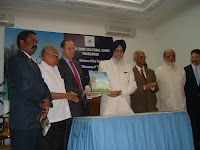An evening at the Raj Bhavan, Guindy


Well, you have to give it to him, really. S Muthiah, chronicler of Madras, is such an amazing man that it is hard to find words to describe him. Here he is with yet another book – even he has lost count of the number, he told me, adding there were more than 30.
‘The Raj Bhavans of Tamil Nadu, a coffee-table pictorial history, is a magnificent book about not only the two Raj Bhavans in Tamil Nadu, but also about the different homes of the governors before they finally moved to the Raj Bhavan in Guindy. Raj Bhavan Ooty was the summer residence-cum-office until the 1930s when the governor and his office staff would be there for about six months. That practice continued till Independence, with shorter stays, and even till 1967 with even shorter stays. That was the year the DMK came to power.
According to Muthiah, the initial brief was to prepare a typical coffee-table book, with pictures and fluffy text. But being the person he is, he declined to do anything like that and suggested instead that a pictorial history of the mansions of the governors of the state was more what he would like to do. This he mentioned today at the release function of the book, where were present Surjit Singh Barnala, the Tamil Nadu governor; P. C. Alexander, former principal secretary to Indira Gandhi, a highly distinguished diplomat who served stints abroad in the UNO and was also governor in Tamil Nadu (1988-90, including President’s rule) and in Maharashtra (1993-2002); Nawab Mohammed Abdul Ali, prince of Arcot; Andrew Simkin, consul general, United States Consulate General, Chennai; Mike Nithavrianakis, British deputy high commissioner, south India; and T.V. Giridhar, director, South Zone Cultural Centre, Thanjavur (publishers of the book).
The venue: the Durbar Hall at the Raj Bhavan, Guindy.
I reached well in time, driving past healthy deer lazing around the sprawling campus. I was hesitant to stop and take pictures as there were a couple of vehicles following me on the narrow pathway. Also, it was my first visit to the governor’s residence and I was wary.
People had already begun arriving; several were seated. There was, of course, the mandatory security check. The press card helped, although I was attending the programme based on Muthiah’s personal invite. The function was scheduled to begin at 5pm and there were 15 minutes to go. There was nothing I could do except sit down in the row allotted for the Press and wait. There was Anwar, the photographer whose pictures of the two Raj Bhavans have added to the exclusivity of the book. Prasad from Pace Systems was there, with his wife. And slowly, many others I knew kept coming.
Just after the stroke of 5 in the evening, there came an announcement: “Please remain standing. His Excellency is arriving.” It was indication, if any were needed, that the tradition of the Raj continues even today in some form or the other.
What surprised me, or rather shocked me, was the utter indiscipline inside the hall even after the governor had arrived and all the dignitaries were seated on the dais. Cellphones kept beeping at intervals, people answered calls, others talked to one another – the only sound missing was a baby’s wail. There were plenty of photographers and video cameramen, so many that I wondered for whom they all worked and which publications or TV channel they represented. A cameraman from a TV channel, for instance, had two others to move around with him. Talk about utilisation of resources! There were also several men who really seemed to have no connection with the proceedings standing below the stage on either side. Were they all employed in the Raj Bhavan, I wondered again.
Thankfully, most of the speeches were short, although none too sweet. Save Alexander’s, and I shall talk about that later. The Nawab of Arcot had a four-page written speech that he managed to cut short to about eight or ten minutes, and many breathed a sigh of relief at the end of it. It was Barnala’s 85th birthday and every speaker wished him happy birthday. There were even Urdu couplets recited, by a gentleman whose name I couldn’t quite gather.
Finally, came time for the national anthem. And when high tea was announced, many were glad that it was all over.
The pictures, which I had taken, show Mike Nithavrianakis receiving the first copy of the book from Barnala; others (l-r) are Giridhar, Muthiah, Alexander, Nawab Md Abdul Ali, and Simkin; and a deer outside the Durbar Hall (your probably will need to blow up the picture to see it; it was dark and my flash weak).
Comments